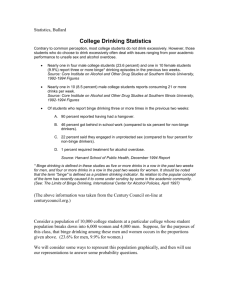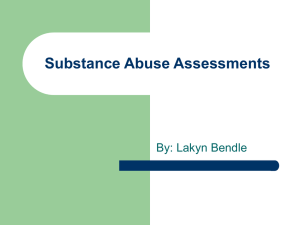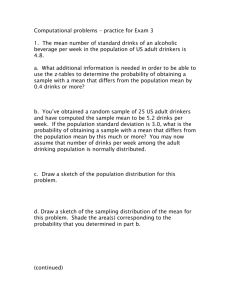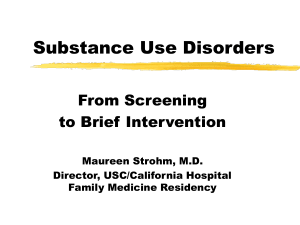We relied on four main sources to construct quality indicators... problems related to consumption of alcohol. Three of these... 2. ALCOHOL DEPENDENCE Patricia Bellas, MD
advertisement
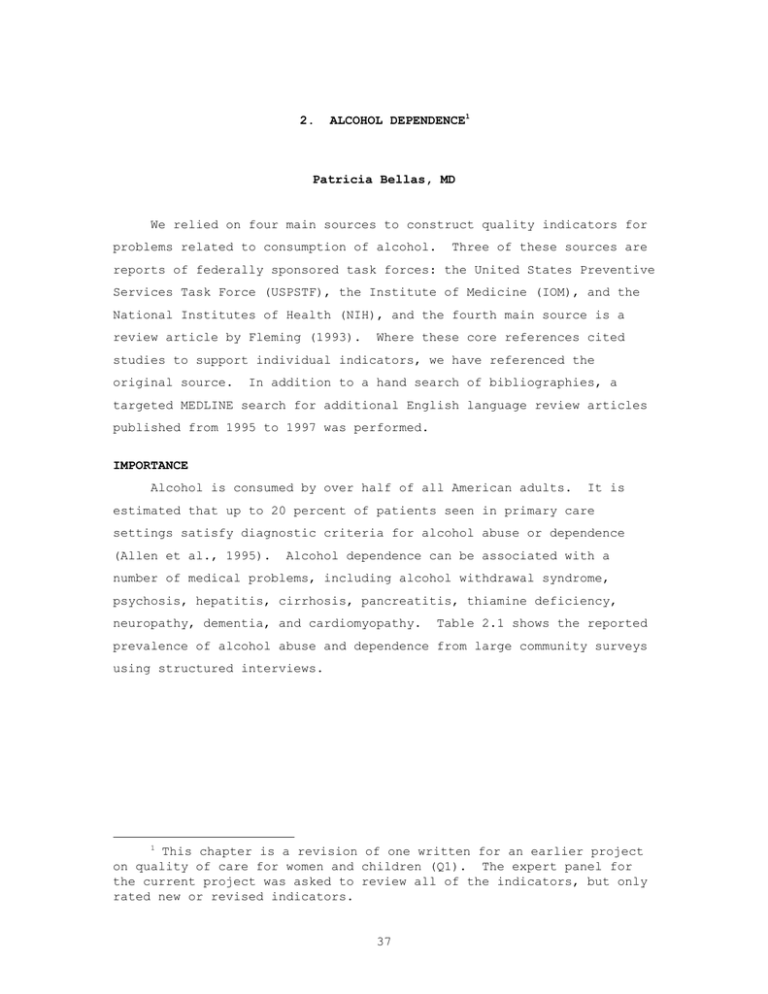
2. ALCOHOL DEPENDENCE1 Patricia Bellas, MD We relied on four main sources to construct quality indicators for problems related to consumption of alcohol. Three of these sources are reports of federally sponsored task forces: the United States Preventive Services Task Force (USPSTF), the Institute of Medicine (IOM), and the National Institutes of Health (NIH), and the fourth main source is a review article by Fleming (1993). Where these core references cited studies to support individual indicators, we have referenced the original source. In addition to a hand search of bibliographies, a targeted MEDLINE search for additional English language review articles published from 1995 to 1997 was performed. IMPORTANCE Alcohol is consumed by over half of all American adults. It is estimated that up to 20 percent of patients seen in primary care settings satisfy diagnostic criteria for alcohol abuse or dependence (Allen et al., 1995). Alcohol dependence can be associated with a number of medical problems, including alcohol withdrawal syndrome, psychosis, hepatitis, cirrhosis, pancreatitis, thiamine deficiency, neuropathy, dementia, and cardiomyopathy. Table 2.1 shows the reported prevalence of alcohol abuse and dependence from large community surveys using structured interviews. 1 This chapter is a revision of one written for an earlier project on quality of care for women and children (Q1). The expert panel for the current project was asked to review all of the indicators, but only rated new or revised indicators. 37 Table 2.1 Prevalence of Alcohol Abuse and Dependence, by Age and Gender Age Group Men Women 18-29 years 17-24% 4-10% 30-44 years 11-14% 2-4% 45-64 years 6-8% 1-2% Over 65 1-3% Source: USPSTF, 1996. <1% Although approximately ten percent of all users meet criteria for dependence, many “problem drinkers” have medical and social problems that can be attributed to alcohol use without true dependence. This condition is often referred to as alcohol abuse or harmful drinking. In addition, many drinkers are at risk for future problems due to regular or binge drinking (also known as “hazardous or problem drinking”). These non-dependent heavy drinkers account for the majority of alcoholrelated morbidity and mortality in the general population. Daily heavy alcohol consumption has been associated with an increase in blood pressure, risk of cirrhosis, hemorrhagic stroke, and cancers of the oropharynx, larynx, esophagus, and liver (USPSTF, 1996). Observational studies have found an increase in all-cause mortality beginning at four drinks per day in men and more than two drinks per day in women (USPSTF, 1996; Fuchs et al., 1995). Nearly one half of the more than 100,000 annual deaths attributed to alcohol are due to injuries, including traffic fatalities, fires, drownings, homicides, and suicides. In 1992, 45 percent of traffic fatalities were related to alcohol (Madden and Cole, 1995), and nearly half of all trauma beds were occupied by patients who were injured while under the influence of alcohol (Gentilello et al., 1995). The far- reaching social consequences of problem drinking are significant. Those who abuse alcohol have a higher risk of divorce, depression, suicide, domestic violence, unemployment, and poverty. unsafe sexual behavior and its sequelae. Intoxication may lead to Children are at risk for an array of psychosocial problems related to alcohol abuse of their parents (USPSTF, 1996). 38 SCREENING The purpose of screening may be two-fold: to identify both regular or binge drinkers, and those who already have experienced the consequences of excessive alcohol abuse or who are dependent on alcohol (see definition below). Early detection and intervention may reduce ongoing medical and social problems due to drinking and reduce future risks from excessive alcohol use (USPSTF, 1996). The American Psychiatric Association (APA) has identified the following components as required for definitions of alcohol dependence: • regular or binge use; • tolerance of psychoactive effects, and/or • physical dependence; and • a pattern of compulsive use with or without interference with social function. The APA (1994) defines alcohol abuse as a social disorder distinct from dependence in that there is no tolerance or pattern of compulsive use, but only harmful social, occupational, psychological, physical, or legal consequences of repeated use. Accurately assessing patients for drinking problems may be difficult. The diagnostic standard is an in- depth, structured interview. Routine measures of biochemical markers such as gamma-glutamyl transferase are probably less sensitive and certainly less specific than clinical history in detecting dependence and abuse (Hoeksema and de Bock, 1993; USPSTF, 1996). Many physicians are unaware of their patients’ problem or hazardous alcohol use. Primary care providers should ascertain regular or binge use by asking patients about the quantity and frequency of their alcohol consumption (Indicator 1). This “regular or binge use of alcohol” is usually defined as more than two drinks per day, 11 drinks per week, or five drinks in any one day in the last month (a “drink” is generally defined in ethanol equivalents, with one ounce representing one to two drinks). In addition, all patients hospitalized for trauma, hepatitis, pancreatitis, or gastrointestinal bleeding should be screened at least once during their hospital stay (Indicator 2). Although estimates of the sensitivity of direct questioning are as much as 50 percent lower than that of self-administered questionnaires, direct questioning can 39 serve as a screen for further evaluation (Fleming, 1993; Cyr and Wartman, 1988; NIH, 1993). Many validated screening questionnaires for alcohol abuse and dependence have been developed that focus on consequences of drinking and perceptions of drinking behavior. The Michigan Alcoholism Screening Test (MAST) reportedly has a sensitivity between 84 and 100 percent and a specificity between 87 and 95 percent for alcohol abuse or dependence (Cyr, 1988). Because the MAST is a lengthy questionnaire, it is not appropriate as a brief screen. Several shorter versions of the MAST, such as the Short MAST (or SMAST), have been proposed, but may be less sensitive and specific (Selzer et al., 1975). The much shorter and more widely used CAGE has only four items and an estimated sensitivity and specificity for alcohol abuse or dependence of to 95 percent, respectively. 74 to 89 percent and 79 However, it is less sensitive for detecting early problem or heavy drinking (USPSTF, 1996). Limitations to the MAST and CAGE as screening instruments are their emphasis on dependence rather than on early problem drinking, and their failure to distinguish between current and lifetime problems. Sensitivity and specificity also are influenced by the “cut score” that is used to define a positive screen (e.g., using one versus two positive responses on the CAGE). Many other questionnaires are available, including the Self-Administered Alcoholism Screening Test (SAAST) (Swenson and Morse, 1975); the Alcohol Use Disorder Identification (AUDIT) (Babor and Grant, 1989); and the Health Screening Survey (HSS) (Fleming and Barry, 1991). In addition, modifications have been made to existing questionnaires for application to special populations, as with the Adolescent Drinking Index (Allen et al., 1995) for young people and the MAST-G for the elderly. These questionnaires may help the clinician better assess the likelihood of problem or binge drinking. Positive responses should be followed with a more detailed interview with the patient or family members to confirm alcohol abuse or dependence (USPSTF, 1996) (Indicator 3). 40 TREATMENT Regular or binge drinkers who do not meet criteria for dependence can benefit from medical intervention (Indicator 4). There have been many clinical trials of the effect of brief office counseling on heavy or problem drinkers. Brief interventions are time-limited strategies that directly focus on reducing alcohol use in the nondependent drinker. These interventions include assessment and direct feedback, contracting and goal setting, behavioral modification techniques, and the use of written self-help materials (NIH, 1993). Treatment goals are usually controlled, moderate drinking instead of abstinence (Wilk et al., 1997). Optimal session length and number of visits have not been established. A meta-analysis by Wilk et al. (1997) reviewed 12 randomized controlled trials (RCTs) of brief counseling. Eligible subjects were heavy drinkers who consumed between 15 to 35 drinks per week. trials excluded dependent drinkers. Most of the Heavy drinkers receiving the brief intervention were almost twice as likely to moderate their drinking for six to 12 months after the intervention compared with the control group (Wilk et al., 1997). In addition, a recently published study (Fleming et al., 1997) of brief physician advice to reduce alcohol describes a significant reduction in seven day alcohol use, episodes of binge drinking, and a two-fold reduction in hospital days in intervention drinkers (men who drank more than 14 drinks a week and women who drank more than 11 drinks a week). Treatment of alcohol dependence is usually divided into three phases: 1. detoxification; 2. treatment and rehabilitation; and 3. relapse prevention. The IOM reviewed more than 60 controlled trials evaluating specific treatments in one or another of these three phases, including inpatient and outpatient rehabilitation, mutual help groups, supportive psychotherapy, disulfuram, benzodiazapines, and aversion therapy. Although various treatment modalities have clinical trial support when compared with no treatment at all, the IOM concluded that there was insufficient evidence to recommend any one modality over another. 41 The Secretary’s Eighth Special Report to Congress on Alcohol and Health (NIH, 1993) came to a similar conclusion, although the authors emphasized the need to tailor the treatment to the individual patient. In particular, they noted a RCT of 200 women in which subjects assigned to a female gender versus a mixed male/female gender treatment group remained in treatment longer and had higher rates of program completion (Dahlgren and Willander, 1989). We propose simply that the medical record should indicate referral for one of the above-mentioned treatment modalities for alcohol-dependent patients (Indicator 5). FOLLOW-UP For alcohol-dependent patients, the core references agree that relapse prevention is the most difficult and least evaluated phase of treatment. Most of the predictors of relapse (psychosocial stressors, mood state, concomitant psychiatric diagnoses) are difficult to modify. Two randomized trials compared aftercare protocols and found no difference in relapse rates by protocol, but did find that those who did not drop out relapsed less often. The outcome could be a result of self-selection of motivated patients. Observational trials of perhaps the most widely known aftercare program, Alcoholics Anonymous (AA), have found that patients who subscribe to the “12-Step” AA philosophy relapse less often (Gilbert, 1991; Cross, 1990), but these results could also be due to patient self-selection. A trial of randomized court-mandated AA meeting attendance versus no treatment showed no long-term difference in the likelihood of relapse (Brandsma et al., 1980). Given this weak evidence, we cannot recommend a quality indicator requiring any particular aftercare program. For nondependent drinkers, there are no clear trials evaluating follow-up separately from brief interventions. It also appears that screening for alcohol use or questioning patients regarding their intake level may have a treatment effect, leading to an overall reduction in consumption (Fleming, 1997). We will follow Fleming’s recommendation that providers review all regular or binge drinkers’ alcohol consumption at subsequent visits (Fleming, 1993) (Indicator 6). 42 REFERENCES Allen J, Maisto S, and Connors G. 1995. Self-report screening tests for alcohol problems in primary care. Archives of Internal Medicine 155: 1726-1730. Babor TF and Grant M. 1989. From clinical research to secondary prevention: International collaboration in the development of the alcohol use disorders identification test (AUDIT). International Perspectives 13 (4): 371-4. Brandsma JM, Maultsby MC, and Welsh RJ. 1980. Outpatient treatment of alcoholism: A review and comparative study. Baltimore, MD: Univ. Part. Press. Committee of the Institute of Medicine, Division of Mental Health and Behavioral Medicine. 1990. Broadening the Base of Treatment for Alcohol Problems. Washington, DC: National Academy Press. Cross GM, CW Morgan, AJ Mooney, et al. March 1990. Alcoholism treatment: A ten-year follow-up study. Alcoholism: Clinical and Experimental Research 14 (2): 169-73. Cyr MG, and SA Wartman. 1 January 1988. The effectiveness of routine screening questions in the detection of alcoholism. Journal of the American Medical Association 259 (1): 51-4. Dahlgren L and A Willander. July 1989. Are special treatment facilities for female alcoholics needed? A controlled 2-year follow-up study form a specialized female unit (EWA) versus a mixed male/female treatment facility. Alcoholism: Clinical and Experimental Research 13 (4): 499-504. Fleming MF. 1993. Screening and brief intervention for alcohol disorders. Journal of Family Practice 37 (3): 231-4. Fleming M, et al. 1997. Brief physician advice for problem alcohol drinkers. A randomized controlled trial in community-based primary care practices. Journal of the American Medical Association 277 (13): 1039-45. Fleming MF, and KL Barry. 1991. The effectiveness of alcoholism screening in an ambulatory care setting. Journal of Studies on Alcohol 52 (1): 33-6. Fuchs CS, MJ Stampfer, GA Colditz, et al. 11 May 1995. Alcohol consumption and mortality among women. New England Journal of Medicine 322 (2): 95-9. Gentilello L, et al. 1995. Alcohol interventions in trauma centers. Journal of the American Medical Association 274 (73): 1043-8. 43 Gilbert FS. 1991. Development of a “steps questionnaire”. Journal of Studies on Alcohol 52 (4): 353-60. Hoeksema HL, and GH de Bock. The value of laboratory tests for the screening and recognition of alcohol abuse in primary care patients. Journal of Family Practice 37 (3): 268-76. Madden C, and Cole T. 1995. Emergency intervention to break the cycle of drunken driving and recurrent injury. Annals of Emergency Medicine 26: 177-179. National Institutes of Health. September 1993. Eighth Special Report to the U.S. Congress on Alcohol and Health -- from the Secretary of Health and Human Services. U.S. Department of Health and Human Services, Washington, D.C. Selzer ML, A Vinokur, and L van Rooijen. 1975. A self-administered short Michigan Alcoholism Screening Test (SMAST). Journal of Studies on Alcohol 36 (1): 117-26. Swenson WM, and RM Morse. April 1975. The use of a self-administered alcoholism screening test (SAAST) in a medical center. Mayo Clinic Proceedings 50: 204-8. US Preventative Services Task Force. 1996. Guide to Clinical Preventative Services, 2nd ed. Baltimore: Williams & Wilkins. Wilk A, Jensen N, and Havighurst T. 1997. Meta-analysis of randomized control trials addressing brief interventions in heavy alcohol drinkers. Journal of General Internal Medicine 12: 274-283. 44 RECOMMENDED QUALITY INDICATORS FOR ALCOHOL DEPENDENCE The following indicators apply to men and women age 18 and older. Only the indicators in bold type were rated by this panel; the remaining indicators were endorsed by a prior panel. Indicator Screening 1. All new patients or those receiving a routine history and physical should be 2 screened for problem drinking. This assessment of pattern of alcohol use should include at least one of the following: • Quantity (e.g., drinks per day); • Binge drinking (e.g., more than 5 drinks in a day in the last month). 2. All patients hospitalized with the 2 following conditions should be screened for problem drinking at least once during their hospital stay. a. trauma; b. hepatitis; c. pancreatitis; d. gastrointestinal bleeding. Diagnosis 3. The record should indicate more detailed screening for dependence, tolerance of psychoactive effects, loss of control, and consequences of use with a validated screening questionnaire (examples include but are not confined to the CAGE, MAST, HSS, AUDIT, SAAST, and SMAST), if the medical record indicates the patient is a regular or binge 3 drinker. Quality of Evidence Literature Benefits Comments II-III Fleming 1993; USPSTF, 1996; NIH, 1993. Reduce alcoholassociated 1 pathology. Diagnosis of alcohol dependence requires regular or binge use. Increased detection of problem drinkers may lead to counseling, detoxification, and ultimately cessation of alcohol intake. In addition, screening may in itself have an intervention effect on those problem drinkers who are not dependent and early identification of those at risk for problem drinking may alter their pattern of drinking with brief counseling intervention. III Madden & Cole, 1996; NIH, 1993; Gentilello, 1995 Reduce alcoholassociated 1 pathology. Hospitalized patients may have a higher prevalence of problem drinking, which frequently goes undetected. There is a high prevalence of problem drinking in those who present with trauma. There is good evidence that interventions to treat both dependent and nondependent drinkers may lead to a reduction in alcohol consumption and may at least reduce hospital day utilization. II Fleming, 1993; Babor & Grant, 1989; Swenson & Morse, 1975; Selzer et al., 1975; USPSTF, 1996 Reduce alcoholassociated 1 pathology. Diagnosis of alcohol dependence requires evidence of dependence, loss of control, and negative consequences. Sensitivity and specificity of questionnaires are 49-100% and 75-95%, respectively. These questionnaires are screening tools for more severe alcohol problems and should be validated by more in-depth interview or referral. Increased detection of alcohol dependence may lead to detoxification, treatment, and cessation. 45 Indicator Treatment 4. Regular or binge drinkers3 should be advised to decrease their drinking. 5. Patients diagnosed with alcohol dependence should be referred for further treatment to at least one of the following: • inpatient rehabilitation program; • outpatient rehabilitation program; • mutual help group (e.g., AA); • substance abuse counseling; • aversion therapy. Follow-up 6. Providers should reassess the alcohol intake of patients who report regular or 3 binge drinking at the next routine health visit. Quality of Evidence I I III Literature Fleming et al., 1997; Wilk et al., 1997; USPSTF, 1996; NIH, 1993 NIH, 1993 Fleming, 1993; Fleming et al., 1997 Benefits Comments Reduce alcoholassociated 1 pathology. There is good evidence that brief counseling can reduce alcohol consumption in problem drinkers. In addition, it may lead to reduced utilization of hospital days. Reduce alcoholassociated 1 pathology. Multiple clinical trials show effectiveness of various treatment modalities, though no one treatment has consistently been demonstrated to be most effective. Reduce alcoholassociated 1 pathology. Prevention of relapse is the most difficult phase of treatment. Experts recommend frequent reassessment to evaluate success of intervention. It appears that simply querying persons regarding their alcohol intake may lead to a reduction in consumption. Definitions and Examples 1 Alcohol associated pathology includes: cirrhosis, pancreatitis, gastrointestinal bleeding, cardiomyopathy, assault, suicide, and motor vehicle accidents. Cirrhosis, cardiomyopathy, and pancreatitis may cause chronic decreases in health-related quality of life due to vomiting, ascites, abdominal pain, bleeding, shortness of breath and may eventually result in mortality. Gastrointestinal bleeding has a short-term mortality risk as well as a chronic impact on health-related quality of life due to anemia and other complications. Motor vehicle accidents and assaults may result in chronic disability from injuries and death. The health-related quality of life of persons other than the patient may also be affected. Liver disease and alcohol-related trauma are more common in women. 2 Screening should consist of an assessment of alcohol use to include at least one of the following: quantity (e.g., drinks per day) and/or binge drinking (e.g., more than 5 drinks in a day in the last month). 3 Regular or binge drinking: a. Patient drinks more than 2 drinks each day; b. Patient drinks more than 14 drinks per week; c. Patient drank more than 5 drinks in a day in the last month. 46 Quality of Evidence Codes I II-1 II-2 II-3 III RCT Nonrandomized controlled trials Cohort or case analysis Multiple time series Opinions or descriptive studies 47
